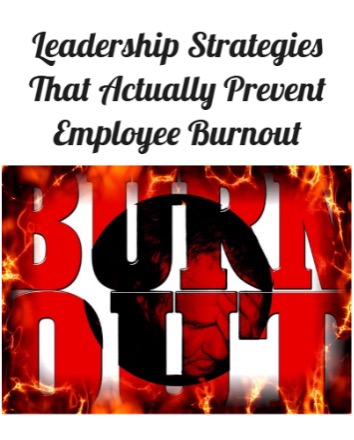Employee burnout is a growing challenge in today’s fast-paced work environments. According to a recent Gallup study, 76% of employees experience burnout at least occasionally, with nearly 28% feeling burned out “very often” or “always” (Gallup). Leaders play a crucial role in preventing burnout, not only to protect employee well-being but also to maintain productivity and retention. Below are leadership strategies that can effectively mitigate burnout and promote a healthier workplace.
- Foster a Culture of Work-Life Balance
Encouraging a healthy work-life balance is essential for preventing burnout. Leaders should set clear boundaries on work expectations, such as discouraging after-hours emails or offering flexible work arrangements. According to a study by the Harvard Business Review, companies that promote work-life balance see a 25% increase in employee satisfaction (Harvard Business Review).
How to Implement:
- Set realistic deadlines and workloads.
- Offer remote or hybrid work options when possible.
- Encourage employees to take their full vacation time.
- Recognize and Reward Contributions
Employees who feel undervalued are more likely to experience burnout. Recognition, whether financial or verbal, fosters engagement and motivation. A report by Deloitte found that organizations with a strong recognition culture have 31% lower voluntary turnover (Deloitte).
How to Implement:
- Establish a structured recognition program with monthly or quarterly awards.
- Provide immediate feedback and praise for achievements.
- Offer meaningful incentives, such as professional development opportunities or additional time off.
- Encourage Open Communication and Psychological Safety
Employees who feel they can express concerns without fear of negative consequences are less likely to suffer from burnout. Leaders should create an environment where employees feel safe to share stressors and challenges. Research by Google’s Project Aristotle found that psychological safety is the number one factor in high-performing teams (Google Research).
How to Implement:
- Hold regular one-on-one check-ins focused on well-being.
- Implement anonymous feedback mechanisms for employees to voice concerns.
- Train managers on active listening and empathetic leadership.
- Provide Growth and Development Opportunities
A lack of career growth can lead to disengagement and burnout. Employees who feel stagnant are more likely to become frustrated and leave their roles. LinkedIn’s 2022 Workplace Learning Report found that 94% of employees would stay at a company longer if it invested in their learning and development (LinkedIn).
How to Implement:
- Offer mentorship programs and career coaching.
- Encourage skill development through workshops and online courses.
- Promote from within and provide clear career advancement paths.
- Lead by Example
Leadership behavior sets the tone for workplace culture. If leaders frequently work long hours, avoid taking breaks, or neglect self-care, employees may feel pressured to do the same. Demonstrating healthy work habits reinforces their importance.
How to Implement:
- Take breaks and encourage employees to do the same.
- Set boundaries for work hours and model balance.
- Share personal strategies for managing stress and well-being.
Conclusion
Preventing employee burnout requires proactive leadership that prioritizes well-being, recognition, communication, growth, and balance. By implementing these strategies, leaders not only improve workplace morale but also enhance productivity and retention. Investing in employees’ well-being isn’t just good ethics—it’s good business.
Gary Brunson
gary@myclearfocus.com
Debra Rider
debra@myclearfocus.com
574.361.2674
Sustainable Growth & Profit Consultant, Coach, Mentor, and Counselor/Therapist for Business Owners and Professionals.


